Discovery of Large Methane Emissions Using a Complementary Method Based on Multispectral and Hyperspectral Data
Abstract
1. Introduction
2. Research Framework
3. Data Source and Methods
3.1. Data Source
3.2. Methods
3.2.1. MBMP (Multi-Band Multi-Pass)
3.2.2. Match Filter
3.2.3. Integrated Methane Enhancement (IME) Method
3.2.4. Calibration Information of Spectral Data
The Conversion from DN Values to Radiance
Atmospheric Correction
Spectral Analysis
Unit Conversion
4. Results
4.1. Identification of Typical Methane Emission Hotspots in China and the United States
4.2. High-Frequency Monitoring of Methane Point Sources
4.2.1. Sanyuan Nan Yao Coal Mine in Shanxi
4.2.2. EOG Shale Gas Well in Eddy County, New Mexico
5. The Proposal of a Tiered Observation Approach
6. Discussion
6.1. Synergy of Multispectral and Hyperspectral Data
6.2. Methane Emission Characteristics
6.3. Implications for Methane Mitigation
6.4. Limitations and Future Directions
7. Conclusions
Author Contributions
Funding
Institutional Review Board Statement
Informed Consent Statement
Data Availability Statement
Acknowledgments
Conflicts of Interest
References
- Saunois, M.; Stavert, A.R.; Poulter, B.; Bousquet, P.; Canadell, J.G.; Jackson, R.B.; Raymond, P.A.; Dlugokencky, E.J.; Houweling, S.; Patra, P.K.; et al. The global methane budget 2000–2017. Earth Syst. Sci. Data 2020, 12, 1561–1623. [Google Scholar] [CrossRef]
- Etminan, M.; Myhre, G.; Highwood, E.J.; Shine, K.P. Radiative forcing of carbon dioxide, methane, and nitrous oxide: A significant revision of the methane radiative forcing. Geophys Res. Lett. 2016, 43, 12614–12623. [Google Scholar] [CrossRef]
- IPCC. Climate Change 2021: The Physical Science Basis; Contribution of Working Group I to the Sixth Assessment Report of the Intergovernmental Panel on Climate Change; Cambridge University Press: Cambridge, UK, 2021; Available online: https://www.ipcc.ch/report/ar6/wg1/ (accessed on 1 January 2022).
- Hmiel, B.; Petrenko, V.V.; Dyonisius, M.N.; Buizert, C.; Smith, A.M.; Place, P.F.; Harth, C.; Beaudette, R.; Hua, Q.; Yang, B.; et al. Preindustrial 14 CH4 indicates greater anthropogenic fossil CH4 emissions. Nature 2020, 578, 409–412. [Google Scholar] [CrossRef]
- Maasakkers, J.D.; Jacob, D.J.; Sulprizio, M.P.; Scarpelli, T.R.; Nesser, H.; Sheng, J.X.; Zhang, Y.; Hersher, M.; Bloom, A.A.; Bowman, K.W.; et al. Global distribution of methane emissions, emission trends, and OH concentrations and trends inferred from an inversion of GOSAT satellite data for 2010–2015. Atmos. Chem. Phys. 2019, 11, 7859–7881. [Google Scholar] [CrossRef]
- Schwietzke, S.; Sherwood, O.A.; Bruhwiler, L.M.P.; Miller, J.B.; Etiope, G.; Dlugokencky, E.J.; Michel, S.E.; Arling, V.A.; Vaughn, B.H.; White, J.W.C.; et al. Upward revision of global fossil fuel methane emissions based on isotope database. Nature 2016, 538, 88–91. [Google Scholar] [CrossRef]
- Brandt, A.R.; Heath, G.A.; and Cooley, D. Methane Leaks from Natural Gas Systems Follow Extreme Distributions. Environ. Sci. Technol. 2016, 50, 12512–12520. [Google Scholar] [CrossRef]
- Frankenberg, C.; Thorpe, A.K.; Thompson, D.R.; Hulley, G.; Kort, E.A.; Vance, N.; Borchardt, J.; Krings, T.; Gerilowski, K.; Sweeney, C.; et al. Airborne methane remote measurements reveal heavy-tail flux distribution in Four Corners region. Proc. Natl. Acad. Sci. USA 2016, 113, 9734–9739. [Google Scholar] [CrossRef]
- Jacob, D.J.; Turner, A.J.; Maasakkers, J.D.; Sheng, J.; Sun, K.; Liu, X.; Chance, K.; Aben, I.; McKeever, J.; Frankenberg, C. Satellite observations of atmospheric methane and their value for quantifying methane emissions. Atmos. Chem. Phys. 2016, 16, 14371–14396. [Google Scholar] [CrossRef]
- Kuze, A.; Kikuchi, N.; Kataoka, F.; Suto, H.; Shiomi, K.; Kondo, Y. Detection of methane emission from a local source using GOSAT target observations. Remote Sens. 2020, 12, 267. [Google Scholar] [CrossRef]
- Jiang, Y.; Zhang, L.; Zhang, X.; Cao, X. Methane Retrieval Algorithms Based on Satellite: A Review. Atmosphere 2024, 15, 449. [Google Scholar] [CrossRef]
- Thompson, D.R.; Thorpe, A.K.; Frankenberg, C.; Green, R.O.; Duren, R.; Guanter, L.; Hollstein, A.; Middleton, E.; Ong, L.; Ungar, S. Space-based remote imaging spectroscopy of the Aliso Canyon CH4 supermitter. Geophys. Res. Lett. 2016, 43, 6571–6578. [Google Scholar] [CrossRef]
- Zhang, Y.; Li, Y.C.; Zheng, Y.F.; He, P. Hyperspectral Remote Sensing Technology of GF-5 Satellite and Its Applications. Remote Sens. 2020, 24, 520–533. [Google Scholar]
- Lu, T.; Li, Z.; Fan, C.; He, Z.; Jiang, X.; Gao, Y.; Xuan, Y.; de Leeuw, G. Methane Retrieval Algorithms for High-Reflectance Surfaces: Lessons from the Permian Basin. Atmos. Meas. Tech. 2020, 13, 6105–6120. [Google Scholar]
- Jervis, D.; McKeever, J.; Durak, B.O.; Sloan, J.J.; Gains, D.; Varon, D.J.; Ramier, A.; Strupler, M.; Tarrant, E. The GHGSat-D imaging spectrometer. Atmos. Meas. Tech. 2021, 14, 2127–2140. [Google Scholar] [CrossRef]
- Irakulis-Loitxate, I.; Guanter, L.; Maasakkers, J.D.; Zavala-Araiza, D.; Aben, I. Satellites detect abatable super-emissions in one of the world’s largest methane hotspot regions. Environ. Sci. Technol. 2022, 56, 2143–2152. [Google Scholar] [CrossRef]
- Vaughan, A.; Mateo-García, G.; Gómez-Chova, L.; Růžička, V.; Guanter, L.; Irakulis-Loitxate, I. CH4Net: A deep learning model for monitoring methane super-emitters with Sentinel-2 imagery. Atmos. Meas. Tech. 2014, 17, 2583–2593. [Google Scholar] [CrossRef]
- Duren, R.M.; Veenstra, B.; Nathan, I. High-Resolution Detection of Methane Plumes from Individual Sources Using WorldView-3. Environ. Sci. Technol. 2022, 56, 8413–8422. [Google Scholar]
- Pandey, S.; Nistelrooij, M.; Maasakkers, J.D.; Sutar, P.; Houweling, S.; Varon, D.J.; Tol, P.; Gains, D.; Worden, J.; Aben, I. Daily detection and quantification of methane leaks using Sentinel-3: A tiered satellite observation approach with Sentinel-2 and Sentinel-5p. Remote Sens. Environ. 2023, 296, 113716. [Google Scholar] [CrossRef]
- Zavala-Araiza, D.; Alvarez, R.A.; Lyon, D.R.; Allen, D.T.; Marchese, A.J.; Zimmerle, D.J.; Hamburg, S.P. Super-emitters in natural gas infrastructure are caused by abnormal process conditions. Nat. Commun. 2017, 8, 14012. [Google Scholar] [CrossRef]
- Pandey, S.; Gautam, R.; Houweling, S.; van der Gon, H.; Sadavarte, P.; Borsdorff, T.; Hasekamp, O.; Landgraf, J.; Tol, P.; van Kempen, T.; et al. Satellite observations reveal extreme methane leakage from a natural gas well blowout. Proc. Natl. Acad. Sci. USA 2019, 116, 26376–26381. [Google Scholar] [CrossRef]
- Schneising, O.; Buchwitz, M.; Reuter, M.; Vanselow, S.; Bovensmann, H.; Burrows, J.P. Remote sensing of methane leakage from natural gas and petroleum systems revisited. Atmos. Chem. Phys. 2020, 20, 9169–9182. [Google Scholar] [CrossRef]
- Liu, Y.-N.; Zhang, J.; Zhang, Y.; Sun, W.-W.; Jiao, L.-L.; Sun, D.-X.; Hu, X.-N.; Ye, X.; Li, Y.-D.; Liu, S.-F.; et al. The advanced hyperspectral imager: Aboard China’s Gaofen-5 satellite. IEEE Geosci. Remote Sens Mag. 2019, 7, 23–32. [Google Scholar] [CrossRef]
- Liu, J.; Liu, X.; Wang, L.; Guo, Y.; Zhao., P. Optimizing Atmospheric Correction through Parallel Acceleration: Reflection Accuracy Analysis of GF-5B Satellite Hyperspectral Sensor Data. In Proceedings of the 2024 3rd International Symposium on Sensor Technology and Control (ISSTC), Zhuhai, China, 25–27 October 2024; pp. 35–38. [Google Scholar] [CrossRef]
- Irakulis-Loitxate, I.; Guanter, L.; Liu, Y.-N.; Varon, D.J.; Maasakkers, J.D.; Zhang, Y.; Chulakadabba, A.; Wofsy, S.C.; Thorpe, A.K.; Duren, R.M.; et al. Satellite based survey of extreme methane emissions in the Permian basin. Sci. Adv. 2021, 7, eabf4507. [Google Scholar] [CrossRef]
- Guanter, L.; Kaufmann, H.; Segl, K.; Foerster, S.; Rogass, C.; Chabrillat, S.; Kuester, T.; Hollstein, A.; Rossner, G.; Chlebek, C.; et al. The EnMAP spaceborne imaging spectroscopy mission for Earth observation. Remote Sens. 2015, 7, 8830–8857. [Google Scholar] [CrossRef]
- Drusch, M.; Del Bello, U.; Carlier, S.; Colin, O.; Fernandez, V.; Gascon, F.; Hoersch, B.; Isola, C.; Laberinti, P.; Martimort, P.; et al. Sentinel-2: ESA’s Optical High-Resolution Mission for GMES Operational Services. Remote Sens. Environ. 2012, 120, 25–36. [Google Scholar] [CrossRef]
- Dwomoh, F.K.; Wimberly, M.C. Fire Regimes and Their Drivers in the Upper Guinean Region of West Africa. Remote Sens. 2017, 9, 1117. [Google Scholar] [CrossRef]
- Varon, D.J.; McKeever, J.; Jervis, D.; Maasakkers, J.D.; Pandey, S.; Houweling, S.; Aben, I.; Scarpelli, T.; Jacob, D.J. Satellite discovery of anomalously large methane emissions from oil/gas production. Geophys. Res. Lett. 2019, 46, 13507–13516. [Google Scholar] [CrossRef]
- Gordon, I.E.; Rothman, L.S.; Hargreaves, R.J.; Hashemi, R.; Karlovets, E.V.; Skinner, F.M.; Conway, E.K.; Hill, C.; Kochanov, R.V.; Tan, Y.; et al. The HITRAN2020 Molecular Spectroscopic Database. J. Quant. Spectrosc. Radiat. Transf. 2022, 277, 107949. [Google Scholar]
- Hersbach, H.; Bell, B.; Berrisford, P. The ERA5 global reanalysis. Q. J. R. Meteorol. Soc. 2020, 146, 1999–2049. [Google Scholar] [CrossRef]
- Wang, H.Z.; Fan, X.T.; Jian, H.D.; Yan, F.L. Exploiting the Matched Filter to Improve the Detection of Methane Plumes with Sentinel-2 Data. Remote Sens. 2024, 16, 1023. [Google Scholar] [CrossRef]
- Dong, D.; Zhang, R.; Guo, W.; Gong, D.; Zhao, Z.; Zhou, Y.; Xu, Y.; Fujioka, Y. Assessing Spatiotemporal Dynamics of Net Primary Productivity in Shandong Province, China (2001–2020) Using the CASA Model and Google Earth Engine: Trends, Patterns, and Driving Factors. Remote Sens. 2025, 17, 488. [Google Scholar] [CrossRef]
- Varon, D.J.; Jacob, D.J.; McKeever, J. Quantifying methane point sources from fine-scale satellite observations of atmospheric methane plumes. Atmos. Meas. Tech. 2018, 11, 5673–5686. [Google Scholar] [CrossRef]
- Varon, D.J.; Jervis, D.; McKeever, J.; Spence, I.; Gains, D.; Jacob, D.J. High-frequency monitoring of anomalous methane point sources with multispectral Sentinel-2 satellite observations. Atmos. Meas. Tech. 2021, 14, 2771–2785. [Google Scholar] [CrossRef]
- Roger, J.; Irakulis-Loitxate, I.; Valverde, A.; Gorroño, J.; Chabrillat, S.; Brell, M.; Guanter, L. High-Resolution Methane Mapping with the EnMAP Satellite Imaging Spectroscopy Mission. IEEE Trans. Geosci. Remote Sens. 2024, 62, 4102012. [Google Scholar]
- Berk, A.; Conforti, P.; Kennett, R.; Perkins, T.; Hawes, F.; Van Den Bosch, J. MODTRAN®® 6: A major upgrade of the MODTRAN®® radiative transfer code. In Proceedings of the 2024 6th Workshop on Hyperspectral Image and Signal Processing: Evolution in Remote Sensing (WHISPERS), Lausanne, Switzerland, 24–27 June 2014; Volume 9088, pp. 1–4. [Google Scholar]
- Thompson, D.R.; Leifer, I.; Bovensmann, H.; Eastwood, M.; Fladeland, M.; Frankenberg, C.; Gerilowski, K.; Green, R.O.; Kratwurst, S.; Krings, T.; et al. Real-time remote detection and measurement for airborne imaging spectroscopy: A case study with methane. Atmos. Meas. Tech. 2015, 8, 4383–4397. [Google Scholar] [CrossRef]
- Thorpe, A.K.; Duren, R.M.; Conley, S.; Prasad, K.R.; Bue, B.D.; Yadav, V.; Foster, K.T.; Rafiq, T.; Hopkins, F.M.; Smith, M.L.; et al. Methane emissions from underground gas storage in California. Environ. Res. Lett. 2020, 15, 045005. [Google Scholar] [CrossRef]
- Foote, M.D.; Dennison, P.E.; Thorpe, A.K.; Thompson, D.R.; Jongaramrun-gruang, S.; Frankenberg, C.; Joshi, S.C. Fast and Accurate Retrieval of Methane Concentration from Imaging Spectrometer Data Using Sparsity Prior. IEEE Trans. Geosci. Remote Sens. 2020, 58, 6480–6492. [Google Scholar] [CrossRef]
- Molod, A.; Takacs, L.; Suarez, M.; Bacmeister, J.; Song, I.S.; Eichmann, A. The GEOS-5 Atmospheric General Circulation Model: Mean Climate and Development from MERRA to Fortuna; Technical Reports Series; NASA: Washington, DC, USA, 2012. [Google Scholar]
- Chen, Z.C.; Jacob, D.J.; Nesser, H.; Sulprizio, M.P.; Lorente, A.; Varon, D.J.; Lu, X.; Shen, L.; Qu, Z.; Peen, E.; et al. Methane emissions from China: A high-resolution inversion of TROPOMI satellite observations. Atmos. Chem. Phys. Discuss. 2022, 22, 10809–10826. [Google Scholar] [CrossRef]
- Looney, B.; Dale, S. BP Statistical Review of World Energy 2021. British Petroleum: London, UK, 2021; pp. 4–6. [Google Scholar]
- Miller, S.M.; Michalak, A.M.; Detmers, R.G.; Hasekamp, O.P.; Bruhwiler, L.M.; Schwietzke, S. China’s coal mine methane regulations have not curbed growing emissions. Nat. Commun. 2019, 10, 1–8. [Google Scholar] [CrossRef]
- Wang, K.; Zhang, J.J.; Cai, B.F.; Liang, S. Estimation of Chinese city-level anthropogenic methane emissions in 2015. Resour. Conserv. Recycl. 2021, 175, 105861. [Google Scholar] [CrossRef]
- Lyon, D.R.; Alvarez, R.A.; Zavala-Araiza, D.; Brandt, A.R.; Jackson, R.B.; Hamburg, S.P. Aerial surveys of elevated hydrocarbon emissions from oil and gas production sites. Environ. Sci. Technol. 2016, 50, 4877–4886. [Google Scholar] [CrossRef] [PubMed]
- Alvarez, R.A.; Zavala-Araiza, D.; Lyon, D.R.; Allen, D.T.; Barkley, Z.R.; Brandt, A.R.; Davis, K.J.; Herndon, S.C.; Jacob, D.J.; Karion, A.; et al. Assessment of methane emissions from the U.S. oil and gas supply chain. Science 2018, 361, 186–188. [Google Scholar] [CrossRef]
- Zhang, Y.; Gautam, R.; Pandey, S.; Omara, M.; Maasakkers, J.D.; Sadavarte, P.; Lyon, D.; Nesser, H.; Sulprizio, M.P.; Varon, D.J.; et al. Quantifying methane emissions from the largest oil-producing basin in the United States from space. Sci. Adv. 2020, 6, eaaz5120. [Google Scholar]
- Johan, C.I.; Eleni, M.; Chris, M. Global Methane Assessment: Benefits and Costs of Mitigating Methane Emissions; Stockholm Environment Institute: Stockholm, Sweden, 2021. [Google Scholar]
- Guanter, L.; Irakulis-Loitxate, I.; Gorroño, J.; Sánchez-García, E.; Cusworth, D.H.; Varon, D.J.; Cogliati, S.; Colombo, R. Mapping methane point emissions with the PRISMA spaceborne imaging spectrometer. Remote Sens. Environ. 2021, 265, 112671. [Google Scholar] [CrossRef]
- Sánchez-García, E.; Gorroño, J.; Irakulis-Loitxate, I.; Varon, D.J.; Guanter, L. Mapping methane plumes at very high spatial resolution with the WorldView-3 satellite. Atmos. Meas. Tech. 2022, 15, 1657–1674. [Google Scholar] [CrossRef]
- Maasakkers, J.D.; Jacob, D.J.; Sulprizio, M.P.; Turner, A.J.; Weitz, M.; Wirth, T.; Hight, C.; DeFigueiredo, M.; Desai, M.; Schmeltz, R.; et al. Gridded national inventory of U.S. methane emissions. Environ. Sci. Technol. 2016, 50, 13123–13133. [Google Scholar] [CrossRef]
- Lyon, D.R.; Zavala-Araiza, R.A.; Alvarez, R.; Harriss, V.; Palacios, X.; Lan, R.; Talbot, T.; Lavoie, P.; Shepson, T.I.; Yacovitch, S.C.; et al. Constructing a spatially resolved methane emission inventory for the Barnett Shale region. Environ. Sci. Technol. 2015, 49, 8147–8157. [Google Scholar] [CrossRef] [PubMed]
- Kholod, N.; Evans, M.; Pilcher, R.C.; Roshchanka, V.; Ruiz, F.; Coté, M.; Collings, R. Global methane emissions from coal mining to continue growing even with declining coal production. J. Clean. Prod. 2020, 256, 959–6526. [Google Scholar]
- Liu, Q.; Teng, F.; Nielsen, C.P.; Zhang, Y.Z.; Wu, L.X. Large methane mitigation potential through prioritized closure of gas-rich coal mines. Nat. Clim. Change 2024, 14, 652–658. [Google Scholar] [CrossRef]
- Bai, S.; Zhang, Y.; Li, F.; Yan, Y.; Chen, H.; Feng, S.; Jiang, F.; Sun, S.; Wang, Z.; Zhou, C.; et al. High-resolution satellite estimates of coal mine methane emissions from local to regional scales in Shanxi, China. Sci. Total Environ. 2024, 950, 14. [Google Scholar] [CrossRef]
- Guanter, L.; Irakulis-Loitxate, I.; Maasakkers, J.D.; Aben, I.; Lelong, C.; Randles, C.A.; Zavala-Araiza, D.; Hamburg, S.P.; Caltagirone, M. Methane alert and response system (Mars): IMEO’s satellite-based system for detection and attribution of methane point sources around the world. In Proceedings of the EGU23, the 25th EGU General Assembly, Vienna, Austria, 23–28 April 2023. [Google Scholar]
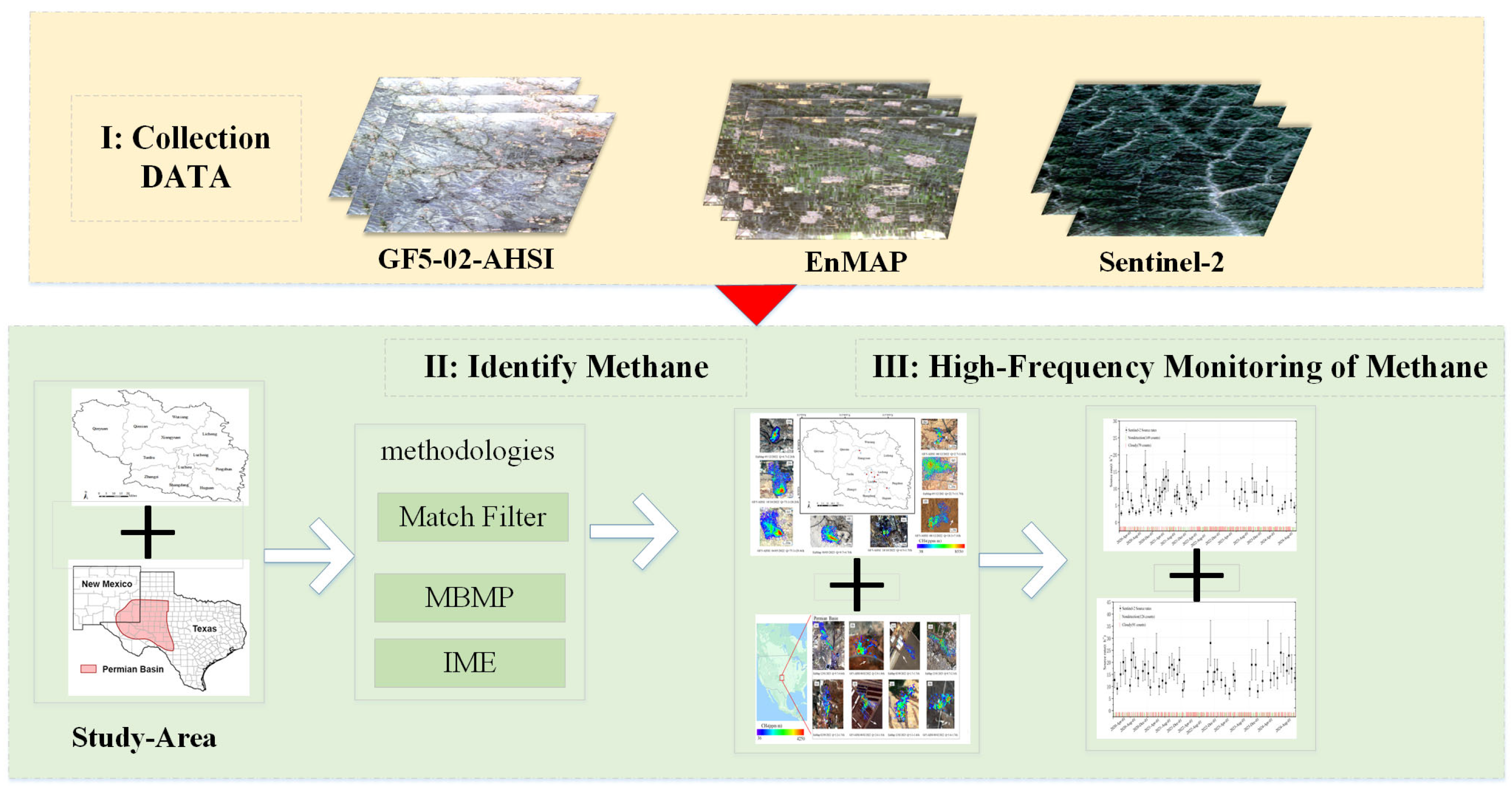
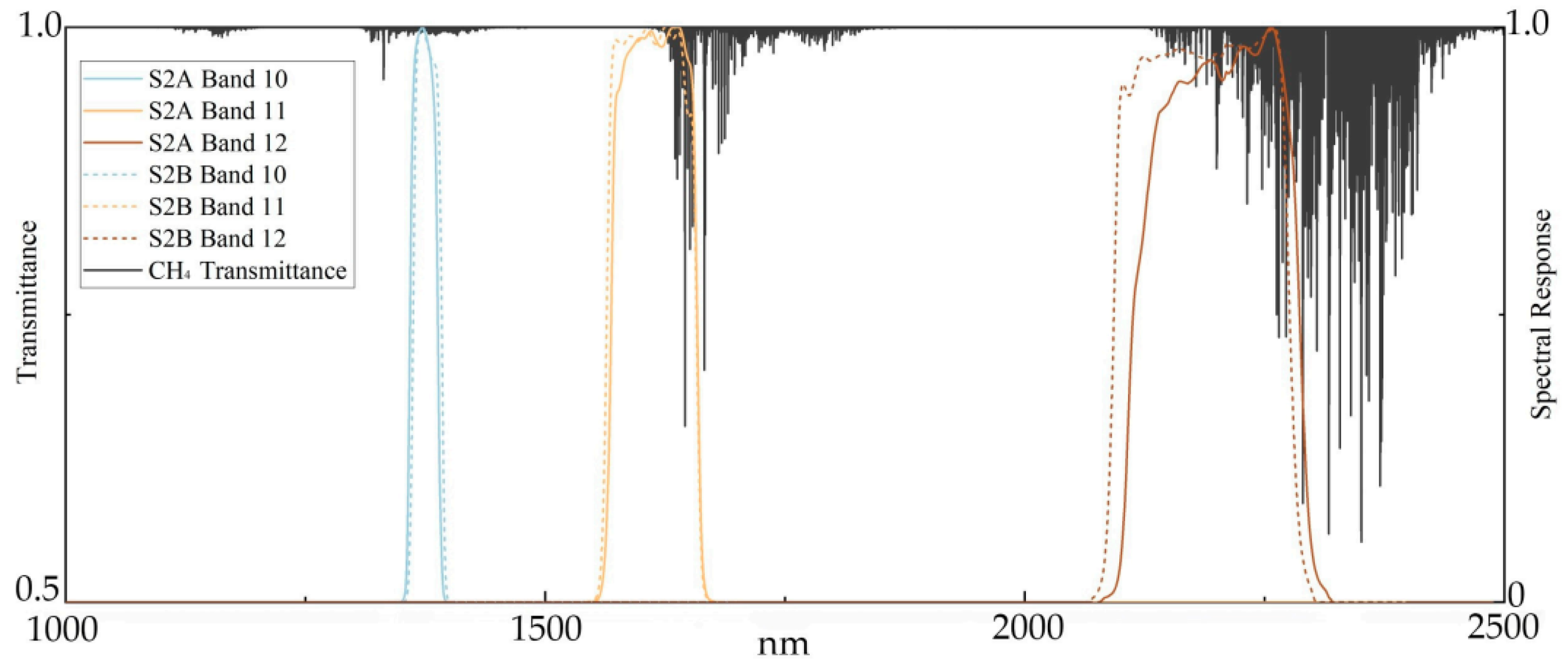
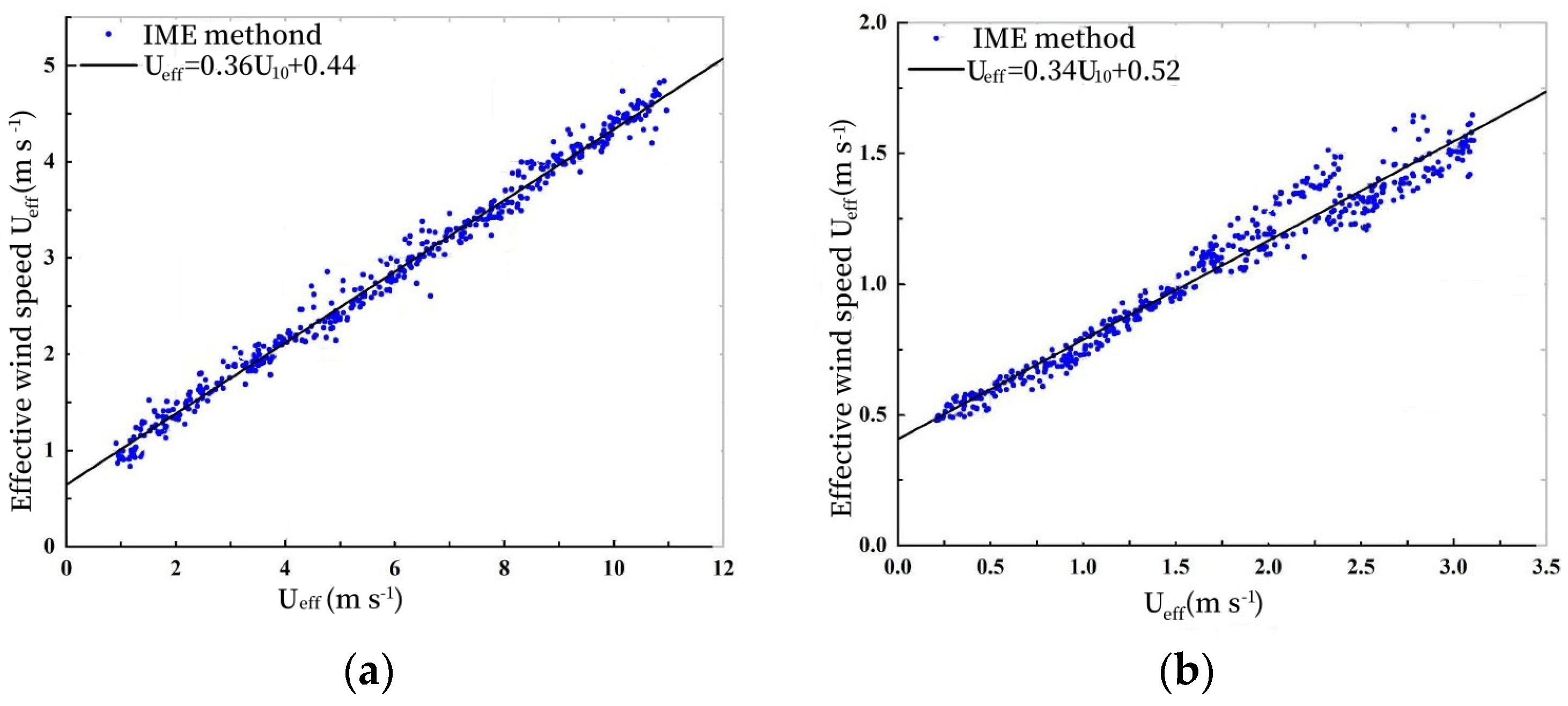
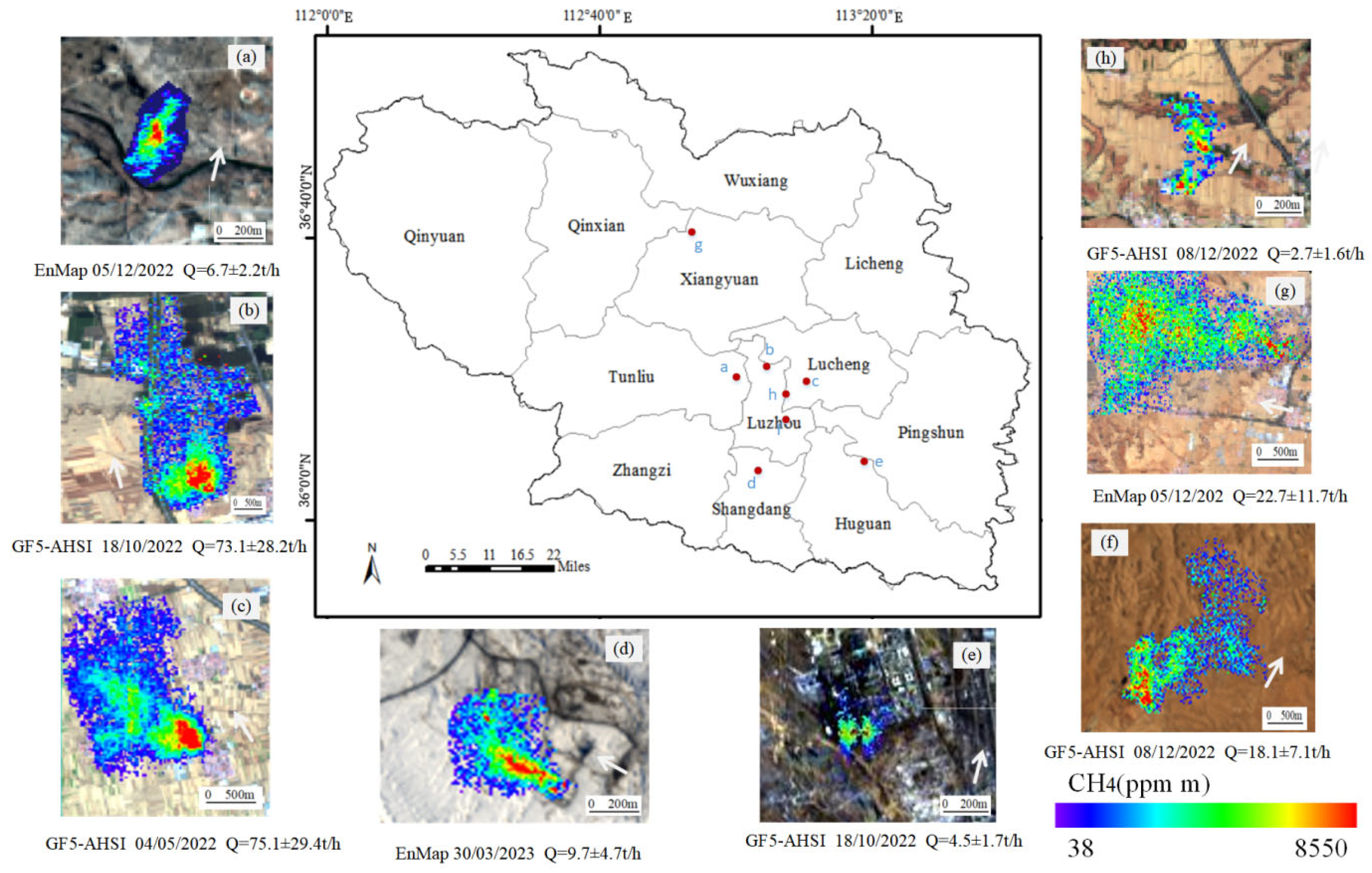
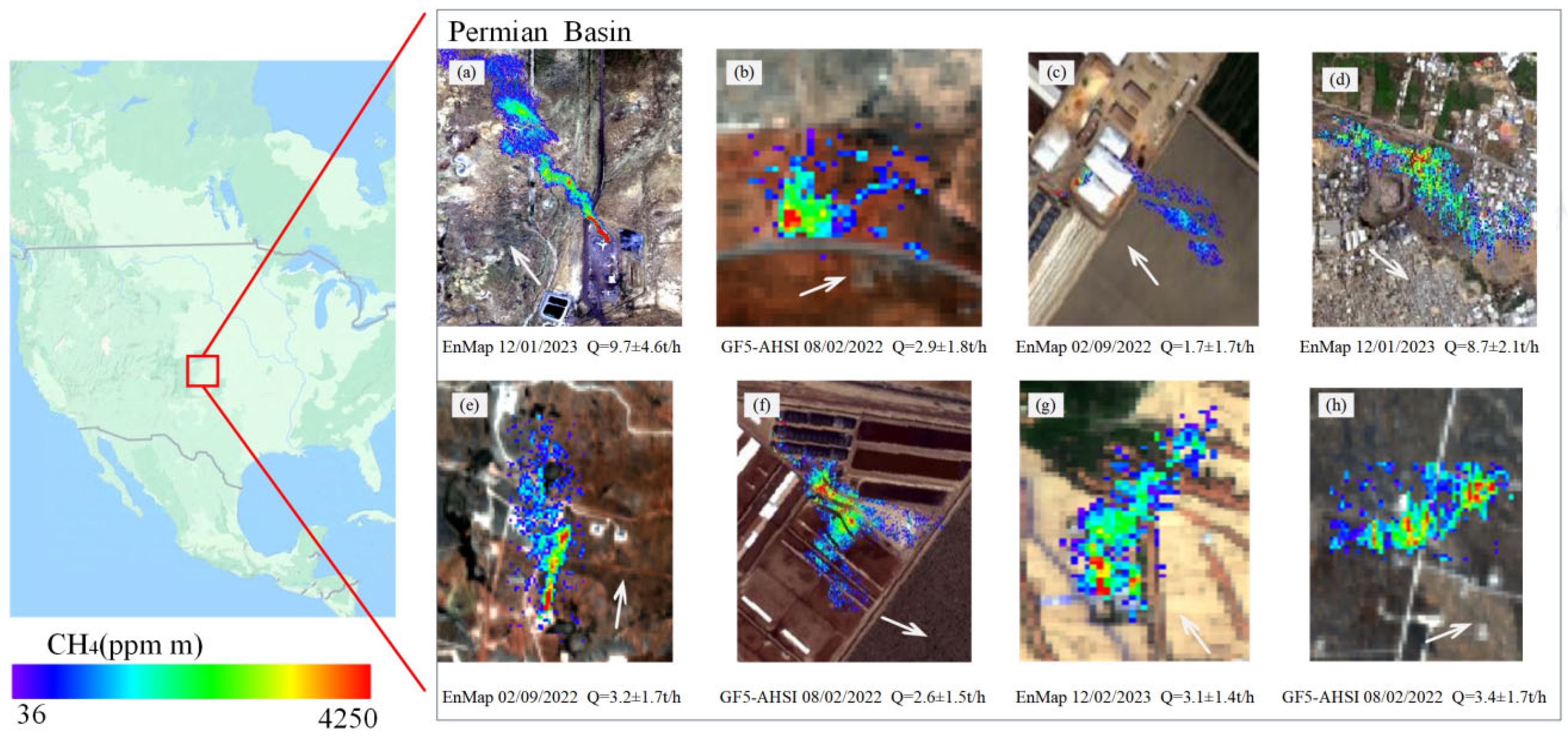

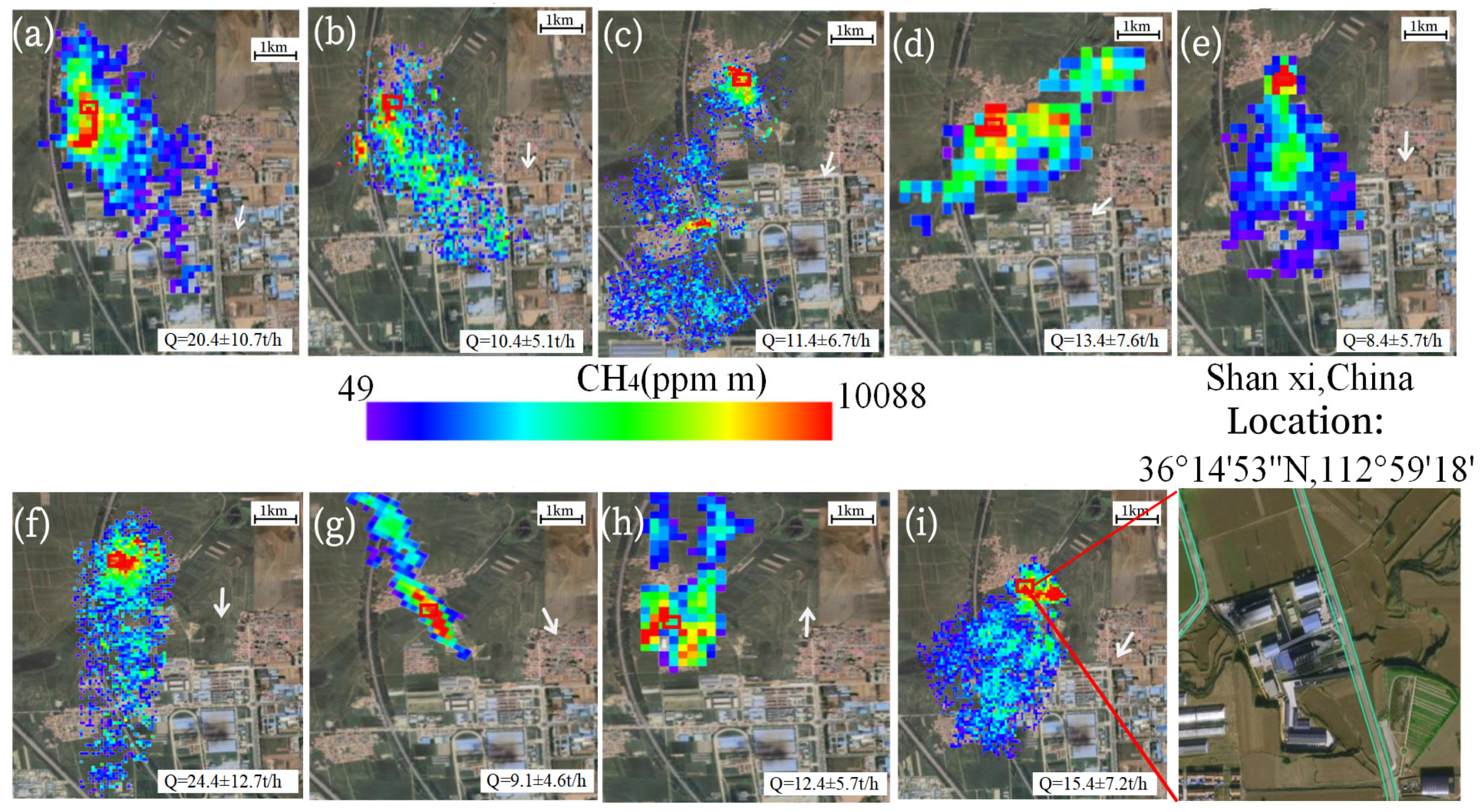
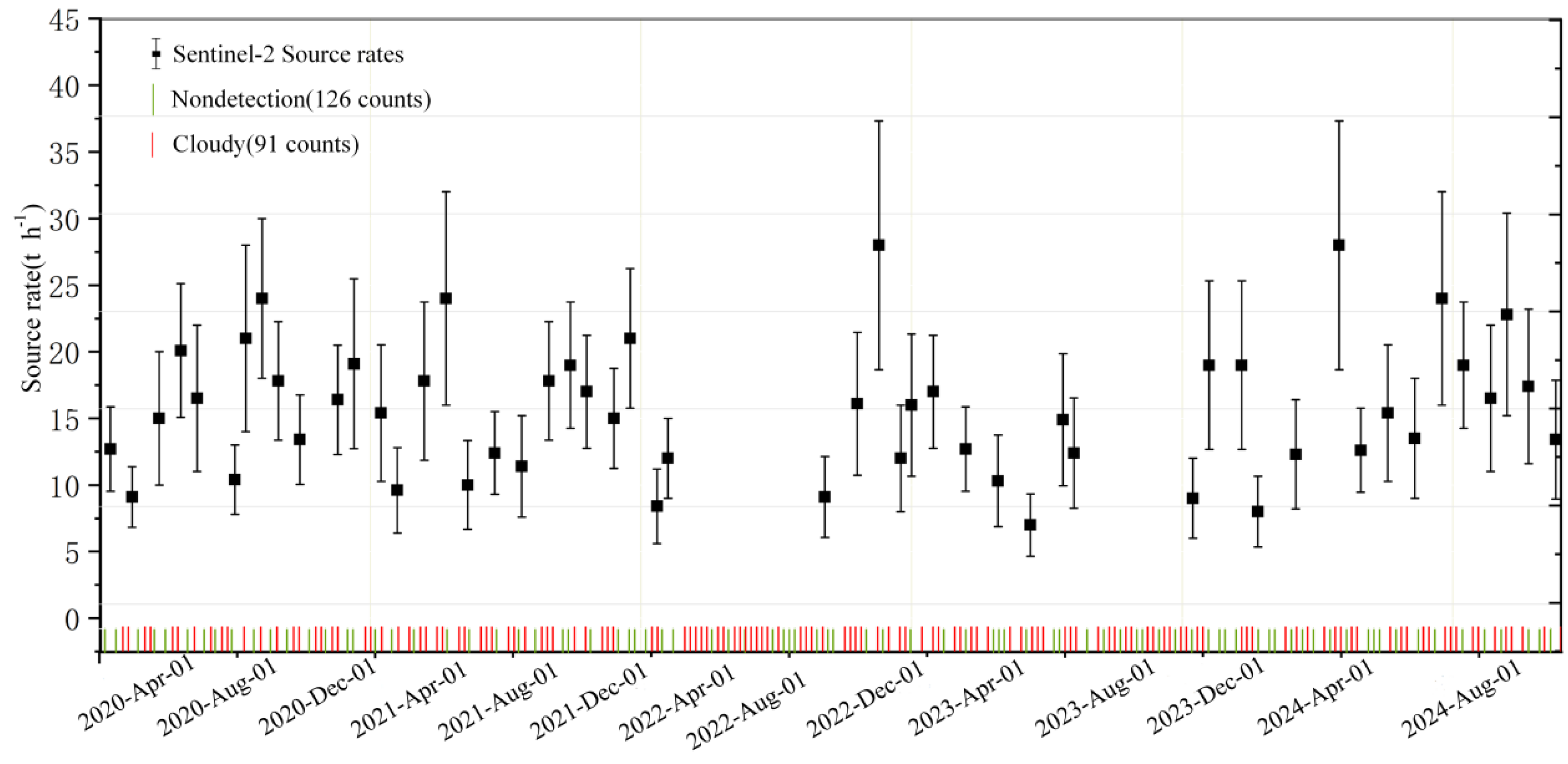

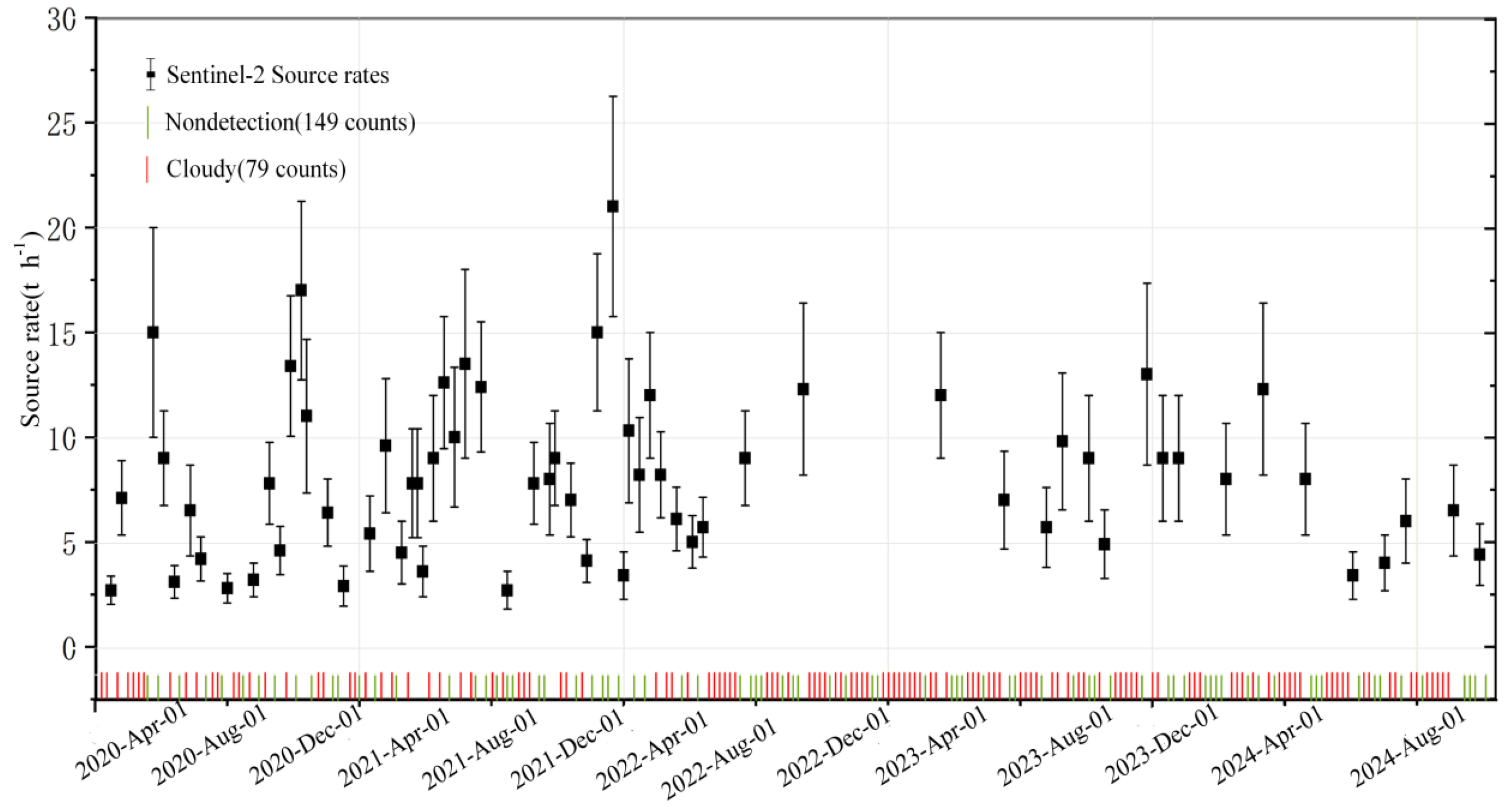

| Figure | Mission | Date | Sector | Lat, Long | Q (t/h) |
|---|---|---|---|---|---|
| Figure 4a | EnMAP | 20221205 | Coal mining | 36.133, 112.565 | 12.7 |
| Figure 4b | GF5-02-AHSI | 20221018 | Coal mining | 36.145, 112.591 | 73.1 |
| Figure 4c | GF5-02-AHSI | 20220504 | Coal mining | 36.123, 113.041 | 75.1 |
| Figure 4d | EnMAP | 20230330 | Coal mining | 36.084, 113.003 | 9.4 |
| Figure 4e | GF5-02-AHSI | 20221018 | Coal mining | 36.105, 113.024 | 4.7 |
| Figure 4f | GF5-02-AHSI | 20221208 | Coal mining | 36.107, 113.072 | 18.1 |
| Figure 4g | EnMAP | 20221205 | Coal mining | 36.203, 112.522 | 22.7 |
| Figure 4h | GF5-02-AHSI | 20221208 | Unknown | 36.103, 113.032 | 2.1 |
| Figure 5a | EnMAP | 20230112 | Gas well | 32.149, −103.995 | 9.7 |
| Figure 5b | GF5-02-AHSI | 20220208 | Oil and gas | 32.604, −104.249 | 2.9 |
| Figure 5c | EnMAP | 20220902 | Oil and gas | 32.301, −104.120 | 1.7 |
| Figure 5d | EnMAP | 20230112 | Unknown | 31.659, −103.543 | 8.7 |
| Figure 5e | EnMAP | 20220902 | Oil and gas | 31.640, −104.038 | 3.2 |
| Figure 5f | GF5-02-AHSI | 20220208 | Gas well | 31.999, −104.125 | 2.6 |
| Figure 5g | EnMAP | 20230112 | Oil and gas | 31.710, −103.766 | 3.1 |
| Figure 5h | GF5-02-AHSI | 20220208 | Gas well | 32.069, −104.026 | 3.4 |
Disclaimer/Publisher’s Note: The statements, opinions and data contained in all publications are solely those of the individual author(s) and contributor(s) and not of MDPI and/or the editor(s). MDPI and/or the editor(s) disclaim responsibility for any injury to people or property resulting from any ideas, methods, instructions or products referred to in the content. |
© 2025 by the authors. Licensee MDPI, Basel, Switzerland. This article is an open access article distributed under the terms and conditions of the Creative Commons Attribution (CC BY) license (https://creativecommons.org/licenses/by/4.0/).
Share and Cite
Cai, X.; Bao, Y.; Huang, Q.; Li, Z.; Yan, Z.; Li, B. Discovery of Large Methane Emissions Using a Complementary Method Based on Multispectral and Hyperspectral Data. Atmosphere 2025, 16, 532. https://doi.org/10.3390/atmos16050532
Cai X, Bao Y, Huang Q, Li Z, Yan Z, Li B. Discovery of Large Methane Emissions Using a Complementary Method Based on Multispectral and Hyperspectral Data. Atmosphere. 2025; 16(5):532. https://doi.org/10.3390/atmos16050532
Chicago/Turabian StyleCai, Xiaoli, Yunfei Bao, Qiaolin Huang, Zhong Li, Zhilong Yan, and Bicen Li. 2025. "Discovery of Large Methane Emissions Using a Complementary Method Based on Multispectral and Hyperspectral Data" Atmosphere 16, no. 5: 532. https://doi.org/10.3390/atmos16050532
APA StyleCai, X., Bao, Y., Huang, Q., Li, Z., Yan, Z., & Li, B. (2025). Discovery of Large Methane Emissions Using a Complementary Method Based on Multispectral and Hyperspectral Data. Atmosphere, 16(5), 532. https://doi.org/10.3390/atmos16050532









